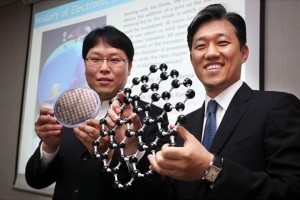
Samsung Advanced Institute of Technology (SAIT), the core R&D incubator for Samsung Electronics, has developed a new transistor structure utilizing graphene. Current semiconductors consist of billions of silicon transistors. To increase the performance of a semiconductor used today, you need to either reduce the size of individual transistors to shorten the traveling distance of electrons, or use a material with higher electron mobility which allows for faster electron velocity.
Graphene possesses electron mobility about 200 times higher then silicon, and a switch to this material could be an alternative path for making faster and more energy efficent devices as it allows faster electron velocity. An issue with using graphene is however that unlike the conventional semiconducting materials, current cannot be switched off because the material is semi-metallic. This has long been a key issue, preventing graphene transistors to be realized.
The industry have for a long time tried to increasing performance in existing semiconductors by reducing the size, but as experts now believe we are nearing the potential limits of scaling down a new solution is required. Alternative materials like graphene has therefore been explored for a long time. Since both on and off flow of current is required in a transistor to represent “1” and “0” of digital signals, using graphene as a solution have been difficult to accomplish because of the materials semi-metallic properties.
Previous research have tried to convert graphene into a semi-conductor, but this approach radically decrease the mobility of graphene and in large remove it’s major benefit over silicone. By re-engineering the basic operating principles of digital switches, Samsung Advanced Institute of Technology has managed to develop a device that can switch off the current in graphene without degrading its mobility.
The institute has solved the most difficult problem in graphene device research and has opened the door to new directions for future studies. The solution uses a graphene-silicon Schottky barrier that can switch current on or off by controlling the height of the barrier. The device demonstrating this approach was named Barristor, after its barrier-controllable feature.
A Schottky Barrier is a potential energy barrier formed at a metal-semiconductor interface. It prevents an electric charge to flow from metal to silicon. The Schottky Barrier is named after a German physicist Walter H Schottky. Generally a metal-semiconductor junction would have fixed work function and Schottky barrier height, but as for graphene the Schottky barrier height can be controlled through the work function.
Samsung Advanced Institute of Technology owns 9 major patents related to the structure and the operating method of the Graphene Barristor.
